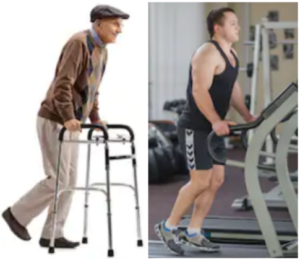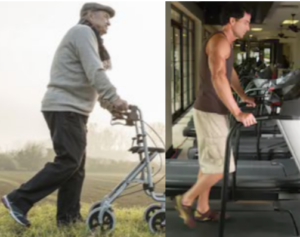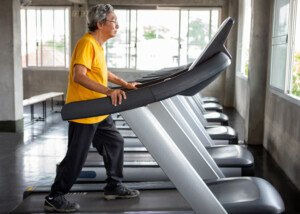
If you hold onto the side of a treadmill when walking, are you aware this mimics using a walker?
You’re training to use a WALKER when you hold onto a treadmill!
The percentage of treadmill walkers who hold on as part of their “exercise” is unbelievable.
This blunder is very prevalent among young and middle-age adults; it’s far from being an “old person thing.”
This replication of using a walker occurs in all ages, all body types, all heights, all weights, even all fitness levels – in that I’ve witnessed even physique athletes and group fitness class participants reducing their walking routine to what a physical therapy patient does at a rehab clinic.
When I was a personal trainer, I’d tell new clients at their first session to warm up on the treadmill for five minutes. I said nothing else. This was a setup to see if they were “grippers.”
Sure enough, as I observed them from a distance, many had their hands on the bar in front or the rails on the sides.
I’d come over to them in the last minute and start talking about how exercise works only when the body is forced to adapt to a training stimulus.
I’d then point out that holding onto a treadmill doesn’t force the body to do ANYTHING.
They’d immediately let go, looking surprised.
Not one of them ever bobbled, teetered or stumbled, let alone fell off.
Holding onto a treadmill is pretty much like using a walker.

The only people who should be holding onto a treadmill are those who needed a walker to get over to the machine in the first place.
Ask yourself how mimicking using a walker will improve your fitness or help you lose weight.
If you don’t need any assistance when you walk in your day-to-day life, ask yourself how supported walking will upgrade your level of fitness, mobility, balance and/or help you lose body fat.

It should be obvious how deactivated her core is as she fake-walks. There is no way that her core will be efficient if she walks at this same speed outside for a prolonged period.
• Hands on the machine means less work done by the core muscles that normally assist in walking.
• Hands-on means your body doesn’t have to balance as much. Omitting this function during walking can backfire.
If you’re trained at supported walking, then you’ll be at higher risk of losing your balance and falling in the real world where there’s nothing to cling onto.
• Older people almost always hold on, which may intuitively seem like the smart thing to do, but hands on the machine only encourages the loss of coordination and core strength, and promotes inefficient ambulation when there’s no fixed object to hold onto.
• Every single one of my older clients whom I told to let go, remained walking without any loss of balance.
• Many younger adults hold on as well, not realizing that this is a complete waste of time.
• If you think you’ll fall off if you let go, then you’re going too fast and/or the incline is too high.
• Instead of holding on, readjust the settings!
Analysis of Using a Walker
“When using a walker, the individual’s body is placed in a flex-forward position, which opens up the spinal canal providing relief from conditions such as stenosis,” says Ali H. Mesiwala, MD, a board certified neurosurgeon with DISC Sports & Spine Center in Newport Beach, CA.
“Most people who use walkers for reasons that have nothing to do with stability find it beneficial because, by opening up the spinal canal, they take the pressure off their nerves to be able to walk a greater distance.
“This is similar to what we see when a patient is using a shopping cart to lean on, and this aids in their ability to walk.
“When using a support system on a treadmill and placing your body in a flex-forward position, this also opens up the spinal canal, but does nothing beneficial in terms of making the exercise more efficient or providing protection to the spine while exercising.
“Using the handrails results in a flex-forward for a position which does not compromise the bony spine, but creates additional stresses on the musculature and adjusts the center of gravity forward, which creates its own set of problems in terms of the efficiency of movement, alteration of gait and by placing additional stresses on muscles that otherwise would not be used during exercise.”
If you want to be more capable at walking, and you don’t suffer from spinal pathalogy, ask yourself how on earth you can achieve better walking in the real world by supporting yourself with the hand rails or bar in front.
Gee, if you’re hooked on holding onto a treadmill, you may as well buy a walker and do laps with it at a track.
You’ll get the same result: a downgrade in your ability to efficiently walk and stop a fall.

 Dr. Mesiwala
Dr. Mesiwala






































